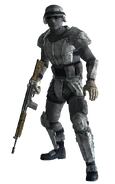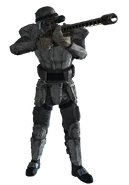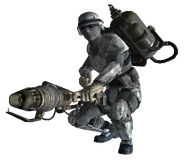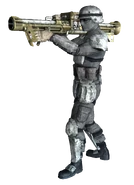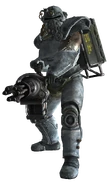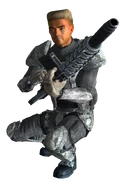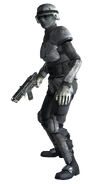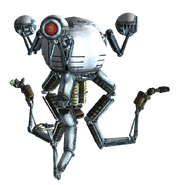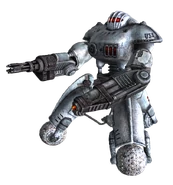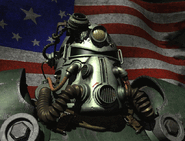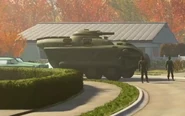The United States Armed Forces were the pre-War federal military forces of the United States of America, consisting of five branches: The Army, Navy, Marine Corps, Air Force, and the Coast Guard. After the bombs dropped, the United States Armed Forces were left without orders from central government and collapsed within the days or weeks after the fallout, although their legacy can be seen and felt in the various wastelands explored throughout the Fallout world.
History[]
Though the civilian government formerly exercised control over the military, the Resource Wars combined with the deteriorating economic situation led to the erosion of civilian authority and gradual transition of a federal republic into a military junta, with the President of the United States exercising dictatorial control over the state.
Following the collapse of the United States in the Great War, surviving USAF military units and servicemen would become a crucial influence on the United States, founding the Brotherhood of Steel, the Enclave, Junktown, or otherwise influencing entire communities.
The United States military was a crucial tool of the United States foreign policy from the beginning and the formation of the Continental Army. Throughout the 20th century, they participated in numerous wars, including the First World War and the Second World War. The Armed Forces have also worked towards the militarization of space, with the first tentative steps being taken during the Virgo II lunar landing.[1] The first steps were taken with the pioneering flight of Defiance 7 on May 5, 1961, when Captain Carl Bell became the first human in space. However, the claim was widely disputed by the Soviet Union and China.[2] By the end of the decade, the United States had achieved victory in the space race, as the Virgo II lunar lander touched down on the surface of Earth's moon on July 16, 1969. Valiant 11 mission members, Captain Richard Wade, Captain Mark Garris, and Captain Michael Hagen became the first humans to walk on the surface of another celestial body[3] - with weapons drawn.[1] With the gradual exhaustion of resources, the space exploration program would peter out by 2034, when the remaining space exploration vehicles like the Delta IX rocket were converted to military ordnance - foreshadowing the eventual fate of the American state.[4]
The Resource Wars[]
An increasingly aggressive foreign policy resulted in the Armed Forces being increasingly used to influence foreign entities. One of the first major examples of this occurred in 2051, when the United States began exerting pressure on Mexico to protect their economic interests there, primarily the crude oil supply. The U.S. deliberately destabilized the country through economic pressure, paving the way for a United States military invasion. American units seized oil refineries and infrastructure to ensure the flow of crude oil did not cease.[Non-game 1] However, it did little to avert the crisis. As the Texan oil fields ran dry, their withering husks revealed to the American public just how deep the resource and energy crisis was, in a landmark 2052 television documentary.[Non-game 2] Not long afterward, rising oil prices worldwide bankrupted smaller nations and led to the European Commonwealth declaring war on the Middle East; the United States was severely affected by the skyrocketing prices of oil.[Non-game 3] The dissolution of the United Nations in July ensured that no international body would mediate between nations, allowing for unrestricted use of military force.[5][6]
Nuclear exchanges in the Middle East and the devastating Euro-Middle Eastern War, coupled with the New Plague reaping a deadly harvest caused the government to initiate Project Safehouse in 2054. Vault-Tec Industries won the contract to construct massive nuclear shelters for the population, becoming a critical defense contractor.[Non-game 4][Non-game 5] Amidst an increasingly chaotic and violent international situation, the United States began to militarize. One of the first major projects emerged in 2059, as the Anchorage Front Line was established in Alaska to protect the state's natural resources and escalating tensions with Canada, as the United States military units demanded permission to guard the Trans-Alaskan Pipeline by stationing troops on Canadian soil.[Non-game 6]
The Sino-American War[]
A year later, in 2060, available fuel reserves were on the brink of depletion worldwide. Traffic on the streets died as fuel became too valuable to waste on cars. The automotive industry desperately tried to come up with a solution to the problem, but electric and early fusion cars were too little, too late to solve the needs of society.[Non-game 7] The problem was further emphasized by the collapse of the European Commonwealth and the Middle East oil powers, as the oil fields were exhausted.[Non-game 8] Together with a deteriorating economy and worsening social climate, the United States began to crack.[Non-game 9] The federal government used the increasing national paranoia to try and control the situation, by discouraging assemblies, fueling the anti-communist sentiment, and encouraging reporting subversive elements.[7] The Vigilant Citizen's Hotline was even established to allow hysterical citizens to report neighbors to the government for any behavior that could be construed as in support of communism.[8] The Third Red Scare is a response to the increased hostility of the People's Republic of China and its operations on American soil.[9]
The military was particularly affected by the fuel shortages, as its vehicle fleets, especially tanks, became crippled by a lack of fuel. In response, the United States Armed Forces initiated a research program seeking to develop power armor in 2065.[Non-game 10] Research, development, and prototyping pave the way for future advances in military, construction, and most importantly, cold fusion technology.[Non-game 11] The military would continue research in other areas continues as well, including more powerful nuclear weapons.[10]
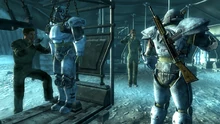
U.S. Army T-51 model B power armor units preparing for deployment in Alaska in January, 2077.
The breakthroughs in technology and possession of oil reserves would result in the United States clashing with the People's Republic of China. As the economy of the communist state was dependent to a much greater degree on fossil fuels than that of the U.S., China found itself on the border of collapse in the spring of 2066, with oil fields finally drying up globally. With the United States unwilling to export its own reserves of crude oil, China became more aggressive in its negotiations.[Non-game 12] According to the Sierra Depot GNN transcript, in June 2074, this resulted in a declaration by the U.S. president that the last known supply of petroleum would be used exclusively by the U.S. and the U.S. would not sell or trade any oil to outside parties.[11] Adding further insult was the first crude fusion cell developed for the power armor project, revealed to the public in summer of 2066.[Non-game 13][Non-game 14]
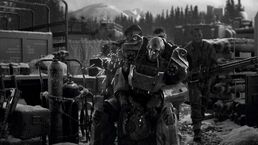
A soldier in power armor undergoing maintenance.
Desperate to avoid collapse, China launched an invasion of Alaska to seize its natural resources. This daring, trans-Pacific military operation began the Sino-American War, the last war the United States would ever fight.[12][Non-game 15] It also inadvertently triggers the gradual annexation of Canada, as the United States forces it to grant the right of passage to American military units on the way to the Alaskan theater.[Non-game 16] As China is fully committed to the Alaskan operation, United States forces find themselves outmatched and pushed back. The T-45 power armor is rapidly prototyped and pressed into production to prevent Chinese tanks and infantry from overrunning Alaska. The first units prove to be incredibly effective in defense, but somewhat lacking in offensive capabilities. As the Chinese military lost the initiative, the situation rapidly deteriorated into trench warfare as neither side was capable of breaking the stalemate and forcing peace terms on the enemy.[Non-game 17]
The war consumed increasing amounts of resources, material, and manpower, straining the ailing American economy. To counteract this, the United States military began to liberally exploit Canadian resources. Protests from Ottawa are ignored as Canada became little more than a colony of the United States.[Non-game 18] Canadian riots and protests eventually culminated in a sabotage attempt on an oil pipeline in 2072. The United States military used the incident as a pretext to invade Canada outright and begin annexation.[12][Non-game 19] On the domestic front, the United States Army contracted RobCo Industries and General Atomics International to collaborate on an unprecedented joint project: The creation of the most powerful combat robot in the history of warfare, to liberate Anchorage, Alaska from Chinese occupation in a display of power meant to demoralize the enemy and force them into submission. The project was meant to serve both military and propaganda needs. The former dictated the capacity, the latter the design: In the words of General Constantine Chase, initiator of the project, Liberty Prime was to embody the American military: A walking, talking, nuke-tossing hero reminding enemies of the U.S. that they picked a fight with a global superpower.[13] Confident that the project would soon yield result, General Chase publicly confirmed in June 2072 that the U.S. Army was working with General Atomics and RobCo to create a superweapon meant to establish the dominance of the United States on the Alaskan front.[14]
Furthermore, the aggressive use of biological weapons by the Chinese led the government to order West Tek to develop a Pan-Immunity Virion on September 15, 2073. The research would eventually evolve into the Forced Evolution Virus project.[15][Non-game 20] Since West Tek was effectively nationalized two years prior (put under military command), the scientists had no other choice but to obey their military masters.[16]
One of the turning points of the War came in 2074, as, despite claims of fighting a defensive war, American infantry and mechanized divisions landed in Asia, in a counter-invasion of Chinese mainland. In the Yangtze Campaign, U.S. Marines rapidly overran Shanghai and Nanjing, securing a major port for bringing in troops and materiel.[17] The economy was stretched to the breaking point as America found itself fighting a war on three fronts: Canada, Alaska, and mainland China. Neither side was willing to yield, despite eight years of constant warfare,[Non-game 21] and ambitious flanking maneuvers such as the Gobi Campaign.[18]
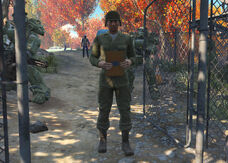
Military forces overseeing administration to Vault 111
By 2076, the war had raged for a decade. Both China and the United States teetered on the brink of collapse. In January, a permanent garrison was installed at West Tek, to ensure that the Forced Evolution Virus project remained safe from international espionage, as it entered a new stage of experimentation on dogs and chimpanzees.[Non-game 22] By the end of the month, the annexation of Canada was completed. Its provinces are put under martial law - all protesters and rioters are shot on sight. Atrocities committed in the name of the Union make their way stateside, fermenting anti-governmental sentiment.[12][Non-game 23]
However heinous the annexation, the military gained an advantage to offset the problems with economic strain. The introduction of the T-51 power armor in June helped tip the scales in favor of the U.S. military. The next-generation power armor resolved problems existing in older generations of armor. Mechanized cavalry units outfitted with the T-51bs were sent to the Alaskan and Chinese fronts, carving a swath through Communist forces. The Chinese economy crumbled under the onslaught and supply lines from nations annexed by the Beijing regime started falling apart.[Non-game 24] However, the American regime did not fare any better. In August, food and energy riots start in urban centers across the United States. A state of emergency and eventually martial law was declared, with U.S. military forces being deployed on the domestic front to fight their own countrymen. The United States became, effectively, a military junta.[Non-game 25]
The Collapse of America[]
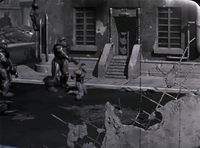
"Our dedicated boys keep the peace in newly annexed Canada."
The counterpoint to this disastrous turn of events came in early 2077, as the Battle of Anchorage ended with a decisive American victory on January 10, after a final offensive spearheaded by T-51 power armor units adapted to the cold environment penetrated Chinese defenses around Anchorage. Despite the embarrassment of the Liberty Prime project, which failed to produce a working weapon for use in Anchorage,[19] General Constantine Chase was credited with the victory.[Non-game 26][20][21] The Anchorage War Memorial was hastily erected on FDR Island to commemorate the efforts and sacrifices of American soldiers on the Alaskan front, basing on an iconic photograph taken in Anchorage.[22][23] The victory in Alaska heralded bad news for American and Canadian citizens, as the military junta in control of the United States deployed mechanized cavalry units to Canada and the United States. Veterans of the Chinese and Alaskan fronts found themselves fighting their own countrymen, quelling riots, and enforcing the national quarantine. Mounting civilian casualties tested the loyalty of soldiers and desertions started to occur. Captured deserters were imprisoned or sent to feed the Army's newest Robobrain development program.[Non-game 27][24]
The campaign in mainland China was reinvigorated by the victory in Alaska and the deployment of T-51 units. Army troops clad in T-51 regularly witnessed Chinese troops surrendering upon sighting them and their miniguns.[25][Non-game 28] However, the effect did not last. As American troops pushed deeper into the mainland, Chinese resistance increased. By October, the situation transitioned from a rout into a stalemate.[26] After a decade of war, there was no end in sight. Billions of dollars and thousands of casualties were spent in vain.[27] To bolster the offensive, bases across the United States were sealed and troops redeployed to provide more men for the meat grinder.[28]
The situation was made worse by the fact that the oligarchs ruling the United States retreated to remote locations around the globe, expecting a last-ditch nuclear strike from China at any moment. The oil rig was claimed by the president and key members of the junta, becoming the foundation of the future Enclave.[Non-game 29] The United States was leaderless, continuing on simply due through inertia. When the U.S. Army security detail at Mariposa discovered the FEV experiments conducted on their comrades in arms – the very men arrested for refusing to fight their own countrymen – they rebel. However, even as Captain Roger Maxson declared them in full desertion from the Army and broke all ties with the United States, there was no response – the chain of command ceased to exist.[29][Non-game 30]
The Great War[]
Nuclear weapons were launched on October 23, 2077. Within two hours, the United States ceased to exist as a nation, its cities vaporized in nuclear fireballs,[29] the former leaders of the country having already retreated to their safe havens. Abandoned by their leaders, the survivors began rebuilding on their own.[Non-game 31]
Legacy[]
Although the United States Army ceased to exist alongside the nation it formally served (and actually controlled), it would continue to influence its history directly and indirectly. The most obvious examples are military hardware present in the wasteland, ranging from humble infantry equipment to the high tech T-51 power armor and military robots. More subtle examples include:
- The Brotherhood of Steel formed by Roger Maxson, which became an important player in wasteland politics. The Appalachian Brotherhood of Steel was based on another Army unit, the Rangers (specifically, Taggerdy's Thunder).
- Pre-War veterans and other survivors who came to Appalachia in 2103 and tried to continue their Army duties. One example is Joe Creigh, who took advantage of the automated training regimen at Camp McClintock to join the Army and continue his family tradition. An example of pre-War U.S. Army soldiers that lived in Appalachia are Captain Fields, Sergeant Radcliff and Sergeant Thompson.
- The Enclave, formed by the descendants of the military-industrial complex that ruled America, which almost managed to commit total global genocide.
- Junktown, founded by a former U.S. Army serviceman.
- The Unity, which came into existence as an unintended result of the FEV research project.
- The 121st Infantry Platoon, nicknamed Firebats, was deployed to Monongah Power Plant after the Great War to protect the power plant from invasion.[30]
Other operations[]
- Anchorage Reclamation, an 11-year campaign to liberate Alaska from the Chinese invaders. Ultimately successful, it was the first large-scale deployment of newly developed T-51b power armor units.
- The annexation of Canada was also performed by the United States military, whose units were also dedicated to keeping the peace―by any means necessary.
- Veterans of the Anchorage campaign were also deployed against their fellow countrymen, to contain food riots.
- The Gobi Campaign, that took place in the Gobi Desert. The Gobi Campaign scout rifle was named for this campaign.
- The Yangtze Campaign, during which Nanjing and Shanghai were occupied by Marines equipped with new, high-tech weapons and armor.
- Soldiers of the U.S. Army's mechanized infantry were stationed on the island of Mambajao in the Philippines on the eve of the Great War.
- Fought in World War II from 1941 to 1945.[31]
- Soldiers/astronauts appear to have been engaged in combat operations on the Moon at some stage prior to the Great War. This is supported by the mural in the Museum of Freedom, which depicts an astronaut with a weapon and the mentioning of the Sea of Tranquillity along with other battles.
Known locations[]
- Toxic Waste Dump Security Bunker
- Sierra Army Depot
- Lost Hills Security Bunker
- U.S. Army field headquarters
- Elemndorf Air Force Base
- West Tek Research Facility
- Mariposa Military Base
- Nellis Air Force Base
- McCarran Airport
- Hidden Valley
- Ashton missile silo
- Hopeville Missile Base
- Pentagon
- Fort Bannister
- Fort Constantine
- Fort Independence
- Raven Rock
- Satellite relay station
- National Guard depot
- Wheaton Armory
- Rivet City
- Adams Air Force Base
- Turtledove Detention Camp
- Naval recruiting center
- Boston mayoral shelter
- Coast Guard Pier
- Federal ration stockpile
- Federal supply cache 84NE
- Federal Surveillance Center K-21B
- Fort Hagen
- Fort Hagen hangar
- Fort Strong
- Listening Post Bravo
- Mount Desert Island Naval Facility
- National Guard training yard
- Recon bunker Theta
- Revere satellite array
- Robotics Technology Facility RB-2851
- Sentinel Site Prescott
- South Boston Military Checkpoint
- The Switchboard
- USAF Satellite Station Olivia
- Wreck of the USS Riptide
- Camp Adams
- Camp McClintock
- Converted munitions factory
- Site Alpha
- Site Bravo
- Site Charlie
- Sugar Grove
Organization[]
Army[]
The United States Army was one of the principal branches involved in projecting American power throughout the Resource Wars and the principal operator of power armor. It was the Army that held the line in Alaska for over a decade and eventually led the decisive push into Anchorage in 2077.[32] Together with the Air Force, the Army also maintained nuclear forces and was responsible for operating the United States arsenal of nuclear weapons through the Commonwealth Defense Administration,[33] The Army military police was also involved in carrying out Executive Order 99066, the internment of Chinese and Chinese-American persons in concentration camps.[34]
Marine Corps[]
Closely cooperating with the United States Navy for mobility, the Marine Corps acted as the United States force in readiness. In the 21st century, the Marine Corps would spearhead assaults into the Chinese mainland in 2074. Despite claims of fighting a defensive war, American infantry and mechanized divisions landed in Asia, in a counter-invasion of Chinese mainland. In the Yangtze Campaign, U.S. Marines rapidly overran Shanghai and Nanjing, securing a major port for bringing in troops and materiel.[35][36]
On the domestic front, the Marine Corps would be responsible for protecting Navy facilities, especially black sites such as Sugar Grove in Appalachia,[37] the Mount Desert Island Naval Facility at Mount Desert Island,[38] participating in war games with other military assets, such as United States Army Rangers,[39] and rounding up civilians for internment in accordance with Executive Order 99066. Due to a shortage of manpower, the USMC would hand these contracts to private military contractors.[34]
[]
It is known to have supported U.S. military operations during the Battle of Anchorage (including the unfortunate sinking of USS Ebon Atoll by USS Interference in December 2066[40]) and participated in the counter-invasion of the Chinese mainland. Naval fighters were responsible for coastal patrols and defense,[41][42] as well as recovery of enemy vessels captured near American shores.[43] In certain cases, the Navy would also cooperate with intelligence agencies such as the DIA in counter-espionage operations.[44]
Like other branches of the United States military, the Navy was involved in a number of illicit activities. The foremost of these was domestic surveillance, carried out using black sites like Sugar Grove, where Naval analysts and operatives monitored U.S. citizens for seditious activity. Appalachia was a notable example of what defined sedition: Anything that could affect the war effort, including unionization, anti-automation protests, striking, and of course, the Free States. Those who caught the eye of the Navy faced a fate worse than death: Edgar Aarsen, a union activist, was marked for surveillance in March 2075. A year later, he was abducted ("arrested"), murdered, and his children set up for adoption.[45]
Air Force[]
The history of the air force is closely intertwined with the general history of the Armed Forces. Together with the Army and the Navy, the Air Force was responsible for maintaining the nuclear arsenal of the United States (primarily bomber-based weapons), as well as aerial warfare in the numerous resource conflicts the United States participated in or outright instigated, including the United States invasion of Mexico of 2051, the Sino-American War (2066–2077), and the United States annexation of Canada.
Coast Guard[]
The United States Coast Guard was established in 1790 by the U.S. Congress, as the Revenue Marine. By the 1860s, it became the U.S. Revenue Cutter Service and arrived at the current designation after it was merged with the U.S. Life-Saving Service in 1915, subordinated to the Department of the Treasury. Since then, it became responsible for domestic maritime protection and law enforcement, targeting smugglers, drug traffickers, and aiding other uniformed services of the United States in the course of their duties.[46]
National Guard[]
The National Guard was a reserve branch of the Army and primarily served as a domestic defense and disaster relief force during peacetime. However, they could be and often were deployed abroad as front-line troops in wartime.[47]
Technology[]
By the time of the Great War, the United States military was the most powerful military in the world, thanks to its overwhelming technological superiority. T-60 power armor, T-51 and the older model, the T-45 provided superb protection and the ability to carry heavy weapons into combat, including rotary cannons usually mounted on gunships or fighters. Power armor units were usually issued to mechanized cavalry formations operating on critical fronts. Low-frequency signals, which can travel far-reaching distances through many geographic obstacles, were used during the Sino-American War to transmit messages to submarines.[48] Other materiel utilized by the Armed Forces included energy weapons, robotics, and military transport vehicles.
Equipment[]
Uniforms of the US Armed Forces[]
Uniforms of the US Armed Forces include both service dress uniforms and combat uniforms that were considered current at the time of the Great War.
- Army Fatigues (Standard Uniform for Soldiers)
- Combat Armor (Protective combat equipment used by most branches of the Armed Forces)
- Military Officer Uniform (Likely worn by those higher up in the chain of command such as high ranking officers and the Joint Chiefs of Staff)
- US Army General outfit (Worn by Generals of the US Army)
- Coast Guard hat (Worn by Coast Guard personnel)
- Marine armor (used by the USMC during amphibious operations)
- Sea Captains Hat (likely worn by Navel officers)
Gallery[]
World War II[]
Anchorage Reclamation[]
United States mainland[]
See also[]
- United States Armed Forces materiel and installations
- Known United States Armed Forces members
- Enclave facilities
- Federal government
- American soldier
- Strike team
References[]
|
Non-game
- ↑ Fallout Bible 0: "2051 Seeking to protect business interests and their oil supply, the United States begins to exert increasing pressure on Mexico, citing the political instability and pollution stemming from Mexico as a threat to the United States. Various economic sanctions serve to destabilize Mexico, and the United States military enters Mexico to keep the oil refineries running and making sure oil and fuel continue to make their way north across the border... at Mexico's expense."
- ↑ Fallout Bible 0: "2052 A television documentary into the withered husk of the Texas oil fields brings the oil shortage into the American households, and reveals how deep the energy crisis runs."
- ↑ Fallout Bible 0: "2052 April The Resource Wars begin. Many smaller nations go bankrupt, and Europe, dependent on oil imports from the Middle East, responds to the Middle East's rising oil prices with military action. The long drawn-out war between the European Commonwealth and the Middle East begins."
- ↑ Fallout Bible 0: "2054 In light of the Euro-Middle-Eastern conflict and the plague scare, the United States sets Project Safehouse in motion. The project, financed by junk bonds, is designed to create shelters, called Vaults, for the populace in the event of a nuclear war or deadly plague. Construction begins late in 2054 and proceeds rapidly due to advances in construction technology."
- ↑ Vault Dweller's Survival Guide inner cover: "NOTICE.––This document contains information affecting the national defense of the United States within the meaning of the New Amended Espionage Act, 50 U.S.C., 31 and 32. Its transmission or the revelation of its contents in any manner to an unauthorized person is prohibited by the law."
- ↑ Fallout Bible 0: "2059 The Anchorage Front Line is established, as the United States increases its military presence in Alaska to protect its oil interests. The Anchorage Front Line causes tensions in the United States and Canada, as the United States attempts to pressure Canada into allowing American military units to guard the Alaskan pipeline."
- ↑ Fallout Bible 0: "2060 Traffic on the streets of the world stops moving. Fuel becomes too precious to waste on automobiles, so alternatives are explored - electric and fusion cars begin to be manufactured, but factories can only make limited amounts. Pressure on fusion research increases."
- ↑ Fallout Bible 0: "2060 The Euro-Middle Eastern War ends as the oil fields in the Middle East run dry... there is no longer a goal in the conflict, and both sides are reduced almost to ruin."
- ↑ Fallout Bible 0: "2062 Despite quarantine measures, the New Plague continues to spread, fueling national paranoia."
- ↑ Fallout Bible 0: "2065 August Increasing need for mobility in the United States mechanized cavalry leads the military to focus the efforts on creating a man-based tank - essentially, a two-legged walking armored unit: Power Armor."
- ↑ Fallout Bible 0: "2065-2067Power Armor research grows and several prototypes are developed, many of which prove to be unworkable in the field. These prototypes pave the way for future advances in military, construction, and fusion technology."
- ↑ Fallout Bible 0: "2066 Spring As the oil resources dry up across the globe, China's fossil fuel dependency causes an energy crisis in the nation. China, bordering on collapse, becomes more aggressive in its trade talks with the United States. Unwilling to export oil to China, talks between the United States and China break down."
- ↑ Fallout Bible 0: "2066 Summer Adding further insult to the Chinese-American relations, the first crude fusion cell is unveiled, one of the results of the Power Armor project. Devices designed for the fusion cell begin to be manufactured. Incorporating fusion power into the general US infrastructure begins, but the process is too slow to supply power to the regions that need it. Nearly thirteen years later, few sections of the United States were supplied with fusion power."
- ↑ Fallout Bible 5: "2066 Summer Adding further insult to the Chinese-American relations, the first crude fusion cell is unveiled, one of the results of the Power Armor project. Devices designed for the fusion cell begin to be manufactured. Incorporating fusion power into the general US infrastructure begins, but the process is too slow to supply power to the regions that need it. Nearly eleven years later, few sections of the United States were supplied with fusion power."
- ↑ Fallout Bible 0: "2066 Winter In the winter of 2066, China invades Alaska. The Anchorage Front Line becomes a true battleground."
- ↑ Fallout Bible 0: "2066 Winter As a sign of increasing tension between the two countries, Canada proves reluctant to allow American troops on Canadian soil or allow American planes to fly over Canadian airspace. The United States and Canadian tensions rise, but Canada eventually backs down, and US troops pass through Canada. This sets the stage for the Canadian annexation in 2076."
- ↑ Fallout Bible 0: "2067 The first suit of Power Armor is deployed in Alaska. While lacking the full mobility of future versions, this Power Armor is incredibly effective against Chinese tanks and infantry. Its ability to carry heavy ordinance becomes key in various localized conflicts, and it has the power to destroy entire towns without endangering the wearer. China rushes to create its own versions, but they are many years behind the United States."
- ↑ Fallout Bible 0: "2069 Canada begins to feel the pressure from the United States military as the US draws upon Canadian resources for the war effort. Vast stretches of timberland are destroyed, and other resources in Canada are stretched to the breaking point. Many Americans refer to Canada as Little America, and Canadian protests are unheard."
- ↑ Fallout Bible 0: "2072 The United States' increasing demand for Canadian resources causes protests and riots in several Canadian cities. An attempted sabotage attempt of the Alaskan pipeline is all the military needs as an excuse to begin its annexation of Canada... which in fact, had already begun in 2067."
- ↑ Fallout Bible 0: "2073 Sept 15 As China becomes increasingly aggressive with their use of biological weapons, the United States government felt that a countermeasure was needed. The Pan-Immunity Virion Project (PVP) is officially formed and plans are made to begin experiments at the West Tek research facility in Southern California."
- ↑ Fallout Bible 0: "2074 Contrary to their claims of seeking only to retake Alaska from the Reds, American Power Armor units, infantry, and mechanized divisions are deployed to China, but they become bogged down on the mainland, putting a further drain on American resources and supply lines."
- ↑ Fallout Bible 0: "2076 January 3 A military team under the command of Colonel Spindel is sent to the West Tek research facility to monitor the experiments in the interest of national security. Captain Roger Maxson (the grandfather of John Maxson, the High Elder of the Brotherhood of Steel in F1) is among the team personnel."
- ↑ Fallout Bible 0: "2076 January The United States annexation of Canada is complete. Canadian protestors and rioters are shot on sight, and the Alaskan Pipeline swarms with American military units. Pictures of atrocities make their way to the United States, causing further unrest and protests."
- ↑ Fallout Bible 0: "2076 June Power Armor prototype completed, resulting in the Power Armor players find in Fallout 1. This is the pinnacle of Power Armor technology before the Great War. Many of these units are sent to China, and they begin to carve a swath through the Chinese forces. The Chinese resources are strained to the breaking point, and the supply lines from the nations China has annexed begin to break down."
- ↑ Fallout Bible 0: "2076 August Food and energy riots begin in major cities throughout the United States. Military units begin to be deployed in cities within the United States to contain rioters, and many temporary jails are constructed. A state of emergency is declared, and martial law soon follows."
- ↑ Fallout Bible 0: "2077 January 10 Alaska is reclaimed, and the Anchorage Front Line is again held by the Americans."
- ↑ Fallout Bible 0: "2077 January 22 The first domestic use of Power Armor within the United States for crowd and quarantine control. Units originally serving in China and the Anchorage Front Line find themselves fighting Americans at home. Food riots increase, and many civilians are killed. Several soldiers defect from the military both in Canada and the United States. They are captured, and are sent to military prisons."
- ↑ Fallout 3 Official Game Guide Game of the Year Edition p.43: "Chinese Army (Simulated)
U.S. Army (Simulated)
With conditions deteriorating between the United States and China, a military presence in Alaska was established to prevent a possible invasion across the Bering Strait. With increasingly scarce oil reserves, a last deep-sea deposit below the Pacific Ocean was claimed by China before allegedly being sabotaged by American special operatives. Strained relationships spiraled downward into conflict as China marched on Alaska, and the Sino-American War of 2066—2077 erupted. Under the command of General Jingwei, the Chinese Army usurped control of Alaska's oil pipeline and reserves. In response, the Americans began what came to be called "The Alaskan Reclamation Operation" (2067—2077).
Under the leadership of General Constantine Chase, the U.S. Army battled fiercely to the front lines of the conflict before Chase began deploying specialized Power Armor units that began pushing the Chinese back. Future Power Armor suits were further refined as the conflict dragged on, and the Trans-Alaska Pipeline was reclaimed. With resources flowing through Canada, strained diplomatic tensions between Canada and the United States becoming problematic, and Canadian forces attacking the pipeline, the country was annexed.
A combination of inclement weather, constant American bombardment and trench warfare, and U.S. Powered Armor unit attacks sweeping through mainline China, the Chinese supply lines weakened and finally broke down completely. By the beginning of 2077, the city of Anchorage was finally liberated, the Chinese eradicated, and the operation deemed a success. A commemorative memorial was erected in Washington, D.C., in honor of the soldiers who fought and perished for the greater American good. Violence between America and pockets of Canadian freedom fighters continued throughout 2077, until the Great War obliterated almost all infrastructure, commerce, and human life."
(Fallout 3 Official Game Guide faction profiles) - ↑ Fallout Bible 0: "2077 March Prepared for a nuclear or biological attack from China, the president, and the Enclave retreats to remote sections around the globe and make contingency plans for continuing the war."
- ↑ Fallout Bible 0: "2077 October Captain Roger Maxson and his men discover that the scientists at Mariposa have been using "military volunteers" (military prisoners who didn't have their brains scooped for use in Brain Bots) as test subjects in their experiments. Morale in the base breaks down, and Maxson executes Anderson, the chief scientist. Not long after this (and in light of the breakdown of the mental breakdown of Colonel Spindel stationed at the base), Maxson's men turn to him for leadership. He shrugs and says 'we should quit.'"
- ↑ Fallout Bible 0: "2077 March Prepared for a nuclear or biological attack from China, the president and the Enclave retreats to remote sections around the globe and make contingency plans for continuing the war."






